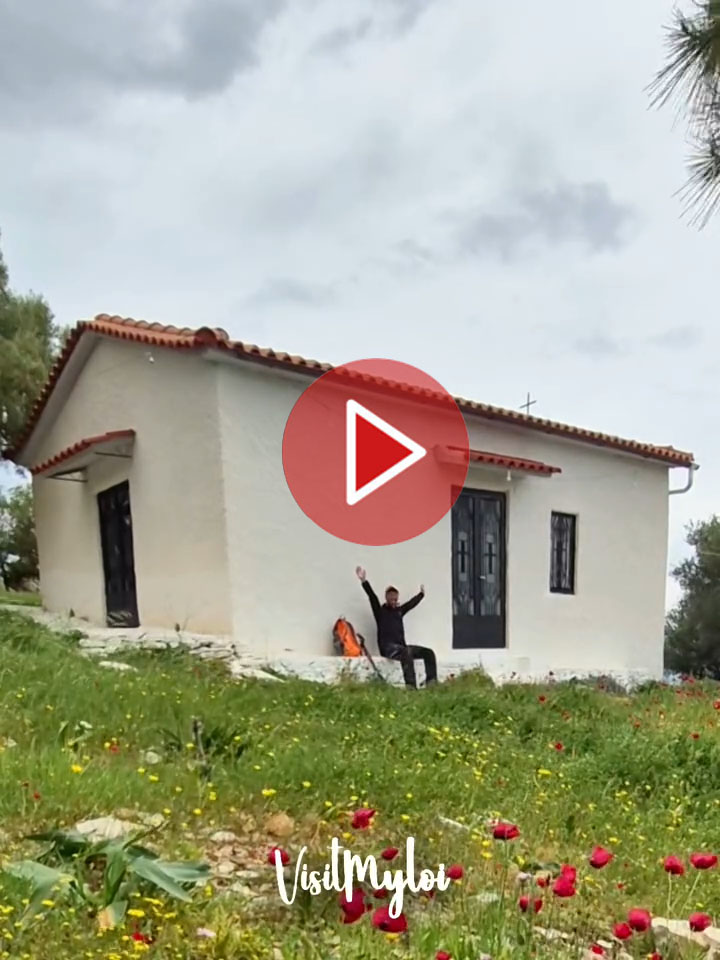Myloi is a charming seaside village in the region of Argolida, in the northeastern Peloponnese. Its name, which means “mills” in Greek, reflects its past as an area rich in water-powered flour mills, thanks to the nearby springs of ancient Lerna. Nestled between the mountains and the Argolic Gulf, Myloi combines natural beauty with historical depth. The village is built near the site of ancient Lerna, known from mythology as the home of the Lernaean Hydra, and rich in archaeological significance. You can still see ruins from different periods, including a Venetian wall, two old train stations, and the nearby medieval Castle of Myloi. Today, Myloi remains a peaceful fishing village, with tavernas lining the waterfront and locals gathering at the pier in the evenings. Its relaxed atmosphere, scenic views, and layered history make it a perfect stop for walkers, history lovers, and travelers alike. This walking route has been created and is offered by VisitMyloi.
1) Startpoint the Lighthouse
1) Startpoint the Lighthouse
The hike begins at the pier and lighthouse of Myloi, offering stunning views over the Argolida Bay. This peaceful spot is more than just a starting point — it’s a favorite gathering place for locals, especially on warm summer evenings. Villagers and young people often come here to socialize, watch the sunset, or celebrate special occasions. It’s not uncommon to witness a beautiful wedding reception unfolding by the water. Right next to the pier, you’ll find local tavernas serving freshly caught fish — often the very same fish that swam in the bay earlier that morning. It’s an ideal place to enjoy a leisurely lunch before or after your walk, with the sea breeze and scenic backdrop adding to the experience.
2) Lerna springs
As you walk along the river’s path toward the sea, you’re following in ancient footsteps. This area, known as Lerna, lies near the village of Myloi on the eastern Peloponnese coast. In classical times, Lerna was famed for its fresh springs and the now-vanished Lake Lerna, once believed to be a mystical gateway to the underworld. It is here that mythology places the fearsome Lernaean Hydra—slain by Heracles in his second labor. Along the way, imagine the life that once flourished here. Archaeological findings reveal that Lerna was inhabited as early as the Neolithic period. One remarkable site is the “House of the Tiles,” a large Early Bronze Age building with some of the earliest known clay roof tiles in Greece. This was also a sacred place. Ancient rites known as the Lernaean Mysteries, dedicated to the goddess Demeter, were held here, near the dark waters of the Alkyonian Lake—once thought to be bottomless. Although the lake has long disappeared, the myths and spiritual aura still linger in the landscape. Walking beside the river, toward the open bay, you’re tracing a path through one of Greece’s oldest stories—where history, legend, and nature flow together.
3) The first station of Myloi
As you follow the walking route through Myloi, you’ll pass a particularly charming and historic part of the village: the old railway stations. Myloi is unique in that it has two old train stations, each telling a different story from Greece’s railway past. The first station, a modest building once operated by the Southern Greece Railways (Σ.Μ.Ε.), was the very first station in Myloi. It served the village until 1891 and stands as a rare reminder of the early days of rail transport in the region.
4) Main Myloi Station
Just a short distance away, you’ll come across the newer station, built between 1887 and 1910, with architecture inspired by French designs and constructed by a Belgian company. This larger complex once included a café, waiting rooms, and wooden restrooms with pitched roofs. Though silent today, these stations offer a glimpse into the days when Myloi was a lively hub of travel and trade.
5) Locomotive shed (remise)
A little further along the tracks stands the locomotive shed (remise)—a large stone-built structure used for housing and maintaining engines. Though now quiet, it reflects Myloi’s past as a lively and strategic rail junction.
Accordion title 1
This is a placeholder tab content. It is important to have the necessary information in the block, but at this stage, it is just a placeholder to help you visualise how the content is displayed. Feel free to edit this with your actual content.
Accordion title 2
This is a placeholder tab content. It is important to have the necessary information in the block, but at this stage, it is just a placeholder to help you visualise how the content is displayed. Feel free to edit this with your actual content.

